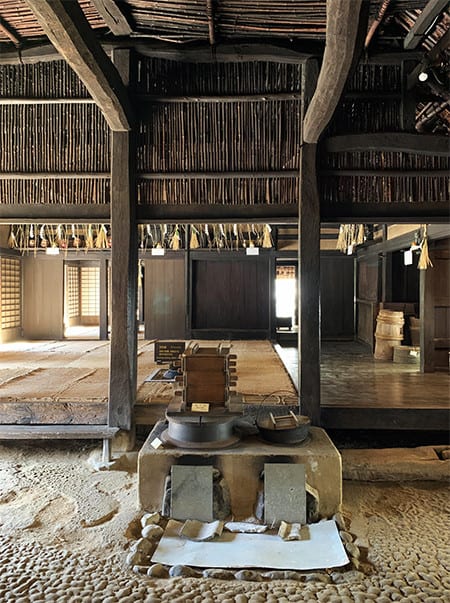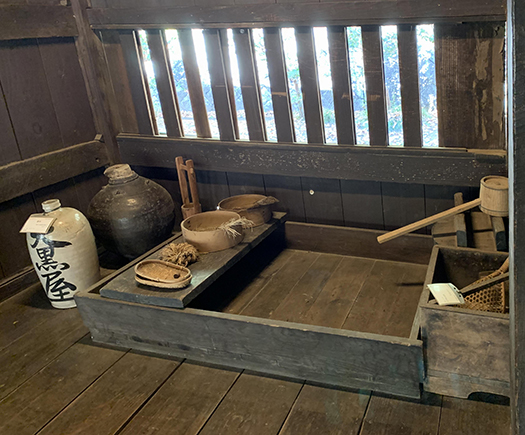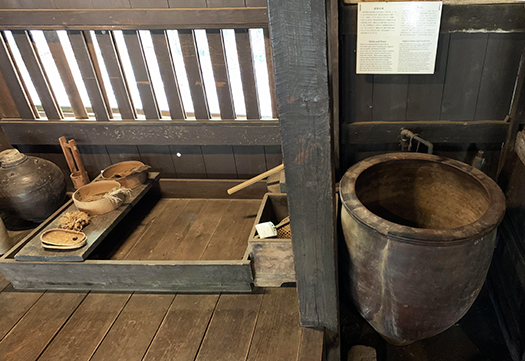



古民家を見ていると、その空間のワンルーム感覚に気付かされる。
細々と壁を造作する手間を掛けられなかった、ということが要因だろうけれど、
いわゆる「個人主義」的な家族内仕切りが日本人的心性からは
あまり発展せず、家族一体型の間取りの仕方が普通であったからだと思う。
そういうなかで個室化があるのは、まずは祖父母の居室であり、
次いで家長自身の居室というように進んでいたのが実際だろう。
家族とは、家系の生業を一体となって支える運命共同体認識だったことが、
多くの民家の間取りからうかがい知ることができると思う。
遙かな後年、北海道の住宅はその高断熱高気密化の過程で、
細かく部屋を仕切って各室毎の温熱環境を工夫するよりも
家全体の断熱気密を考えていく「全室暖房」という考え方が自然になった。
そうすると細かく用途毎に部屋として区切るよりも
大きなワンルームという志向性が高まっていった。
そういう家の考え方と古民家の空間性にはどうも共通要素があると思う。
まったく違う経緯からの選択だけれど結果は同じような空間志向になった、みたいな。
この南関東・秦野の家ではかまどがドーンと中央に鎮座する。
土間と竹スノコ床の中心居室ヒロマの境界に置かれて、
暖房と加熱調理の両方の役割を担っていたことがあきらかな配置。
かまどは土を塗り固めて造作するモノであり、内部でバイオマスを燃焼させる。
加熱調理のパワーを集中させるのがメインの役割だが、
この土塗りという組成から室中にゆったりとした「輻射熱」を放射する。
日本ではいわゆるペチカのような暖房器具は発展しなかったとされるけれど、
しかしこのかまどを見れば、ペチカとほぼ同様に機能したのではないか。
この家の場合、配置が絶妙でありヒロマの囲炉裏もこのペチカと近接配置。
かまど・囲炉裏・流しと接近しているので、非常に合理的な動線が垣間見える。
かなり複合的な温熱感を人々に与えたのではないだろうか。
さらに◎の位置には調理のための空間が配置されている。
先日のブログでも書いたけれど、この時代の台所・調理は「座って」行っている。
現代人は当然のように「立って」調理することに慣れているから奇異に感じる。


しかし、『台所道具の歴史(⑨)』という本で著者の栄久庵憲司さんは
〜「座って調理をしていた日本人が、立って仕事をするようになったのは
台所史上の大事件である。・・・高度な料理をめざし、しかも主婦の負担を軽くしようと
したのが『立働式』台所の成因であろう。」 元来、生活様式全般が床座式である
日本では、台所も例外ではなく、かまどや流しも床に作られ炊事作業は
座って行われていた。広い空間で比較的単純な食事の用意をし、女性の地位が
低い時代は座って炊事をすることが一般的であった。〜と述べている文章を発見。
不勉強でしたが、まことに膝を打つ思いがしました。
写真のような調理空間では、甕から水を柄杓で掬って「流し」で何かを洗うにも
なかなか大変だったことがわかる。
この家の解説でも座り姿勢での調理はしにくかったという記述もあった。
日本女性の常時姿勢が「立て膝」であることの意味もなんとなく見えてくる。
土間は火力調理には適しているが、より衛生的な環境が要求される
「洗う、切る」といった基本調理は、こういった板座の空間で行われたのだろう。
そして頻繁に土間の火力調理をチェックする必要性から
常時姿勢は立て膝でいるほうが臨機応変であったのだと思われる。
う〜む、今度一回、立て膝姿勢で調理してみようかなぁ。
どう考えても、複数料理の進行には適していないと思うし、
切ることだけを考えても、力の発揮に難があるように思われる・・・。
っていうか、日本の住宅に「床」が普遍化したのは、
それほどの歴史時間ではないとされる。調理空間はまだ過渡的だった?
古来からの「調理」方法の推移を研究しなければならないでしょうね。
おお、料理&歴史男子の血が騒いできた(笑)。
English version⬇
[Kamado stove & sitting posture cooking / Japanese good house ㉒-2]
Looking at an old folk house, you will notice the feeling of a studio in the space.
It may be because I couldn't take the trouble to make the wall in detail.
The so-called "individualist" family partition is from the Japanese spirit
I think it was because it didn't develop much and the family-integrated layout was normal.
Under such circumstances, the first thing that has become a private room is the grandparents' room.
Next, the fact was that the patriarch's own room had progressed.
The fact that the family was a fateful community recognition that supported the livelihood of the family as one
I think you can tell from the floor plans of many private houses.
A long time later, houses in Hokkaido were in the process of being highly insulated and airtight.
Rather than partitioning the rooms into small pieces and devising a thermal environment for each room
The idea of "heating all rooms", which considers the heat insulation and airtightness of the entire house, has become natural.
Then, rather than dividing it into rooms for each purpose
The intention of being a large studio has increased.
I think there is something in common between the way of thinking of such a house and the spatiality of an old folk house.
It seems that the selection was made from a completely different background, but the result was a similar space orientation.
In this house in Hadano, South Kanto, Kamado sits in the center with Dawn.
Placed on the border of the central living room Hiroma of the dirt floor and the bamboo drainboard floor,
Arrangement that was clearly responsible for both heating and cooking.
Kamado is a product made by painting soil and burning biomass inside.
The main role is to concentrate the power of cooking,
From this composition of earth coating, a relaxing "radiant heat" is radiated into the room.
It is said that heating appliances such as so-called stoves did not develop in Japan,
However, if you look at this kamado, it seems that it worked almost the same as a stove.
In the case of this house, the arrangement is exquisite and the hearth of Hiroma is also arranged close to this stove.
Because it is close to the kamado, hearth, and sink, you can get a glimpse of a very rational flow line.
I think it gave people a fairly complex feeling of heat.
Furthermore, a space for cooking is arranged at the position of ◎.
As I wrote in my blog the other day, the kitchen and cooking of this era is "sitting".
It feels strange because modern people are naturally accustomed to "standing" cooking.
However, in the book "History of Kitchen Tools (9)", the author, Kenji Ekuan, said
~ "The reason why Japanese people who were sitting and cooking started to stand up and work
This is a big event in the history of the kitchen.・ ・ ・ Aiming for advanced cooking and reducing the burden on housewives
That was probably the origin of the "standing-up" kitchen. Originally, the overall lifestyle is a floor-sitting type.
In Japan, the kitchen is no exception, and the kamadoya and sink are made on the floor and the cooking work is done.
It was done sitting down. Prepare a relatively simple meal in a large space, and the status of a woman
In the low days, it was common to sit down and cook. I found a sentence that states.
I didn't study, but I really felt like hitting my knee.
In a cooking space like the one in the picture, you can scoop water from the jar with a cassotte and wash something with a "sink".
It turns out that it was quite difficult.
The meaning of the constant posture of Japanese women being "standing knees" can be seen somehow.
The dirt floor is suitable for thermal cooking, but a more hygienic environment is required.
Basic cooking such as "washing and cutting" was probably done in such a space on the board.
And from the need to check the firepower cooking in the soil frequently
It seems that the constant posture was more flexible when standing on the knees.
Hmmm, let's cook in a standing knee position once again.
By all means, I don't think it's suitable for the progress of multiple dishes,
Even if you just think about cutting, it seems that there is a difficulty in demonstrating power.
You will have to study the transition of "cooking" methods from ancient times.
Oh, cooking & history The blood of boys is making noise (laughs).



















